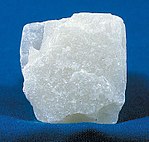Minerals
What is a mineral?
Defining a mineral. A mineral is a naturally occurring inorganic solid, with a definite chemical composition, and an ordered atomic arrangement.
minerals possess definite physical properties by virtue of which they can be distinguished from one another. the most important physical properties are as follows:
Colour:
Some minerals possess a characteristic colour, e.g. galena, magnetite, olivine, etc' but in some others, the colour is variable e.g. quartz.
Specific gravity:
Most rock_forming minerals have a specific gravity between 2 and 4.
Lustre:
the lustre may be metallic (line galena or iron pyrites), pearly (like talc), or silky.
Taste and smell:
Rock salt, alum, and other minerals can be recognized by their taste.
Streak:
When drawn over paper or an unglazed porcelain plate, a few minerals leave a coloured mark known as the streak; for instance, graphite gives a black streak; hematite leaves a cherry red streak.
Crystalline:
A crystal is a geometrical solid bounded by smooth plain surfaces called faces and capable of increasing in size by the deposit of fresh material on the outside of these surfacers. The faces in a crustal show a definite geometrical pattern and the angles between the faces are constant for example, quartz crystallises in the hexagonal system, while mica or muscovite crystallises in what is called the monoclinic system, and rock salt, in the cubic system. the crystallisation may take place by:
- Deposition from solution
- Slow cooling from the molten state, or
- Direct change from vapour to a solid.
Cleavage:
Many crystals have the tendency to split along, one or more directions parallel to an actual or possible crystal face. This splitting gives plane surfaces known as cleavage planes at right angles, forming perfect cutes.
Fracture:
When a crystal breaks independently of the cleavage plane, it is said to fracture. The property is prominent in minerals with poor cleavage.
Hardness:
This term gives the relative ease with which minerals can be scratched. In practice hardness is measured by reference to a set of minerals given below so arranged that the first member can be scratched by all the others, the second by all accept the first, and so on.
Moh's scale of hardness is as follows:
Moh's scale of hardness
| Mohs hardness |
mineral |
Chemical formula |
Image |
| 1 |
Talc |
Mg3Si4O10(OH)2 |
 |
| 2 |
Gypsum |
CaSO4·2H2O |
 |
| 3 |
Calcite |
CaCO3 |
 |
| 4 |
Flourite |
CaF2 |
 |
| 5 |
Apatite |
Ca5(PO4)3(OH−,Cl−,F−) |
 |
| 6 |
Orthoclase
feldspar |
KAlSi3O8 |
 |
| 7 |
Quratz |
SiO2 |
 |
| 8 |
Topaz |
Al2SiO4(OH−,F−)2 |  |
| 9 |
Corundum |
Al2O3 |  |
| 10 |
Diamond |
c |  |
It may be observed that:
A fingernail will scratch up to about 2.5.
A pen or a knife will scratch up to 6.5.
When testing the hardness of mineral window glass can be used as a substitute for apatite.
Protodyaknov strength number:
The hardness of rock is expressed by the Protodyaknov strength number in Russia. the number indicates the relative ease with which a rock can be broken, e,g, strong lignites and weak clay shales have Protodyaknov strength number of 1.5 to 2, strong coals and anthracite have strength number of 2; exceedingly strong quartzites and gabbro-diorites have the number as 20 to 25, the highest number. other rocks have the numbers in between.
electrical and magnetic properties of minerals and the properties dependent on light are also made use of in distinguishing minerals which react in a distinctive manner to the tests.



















Comments
Post a Comment